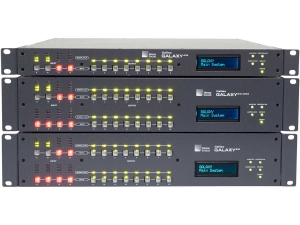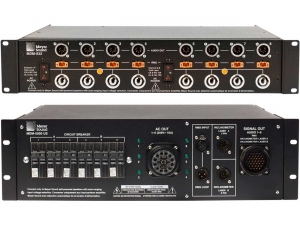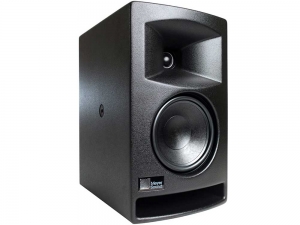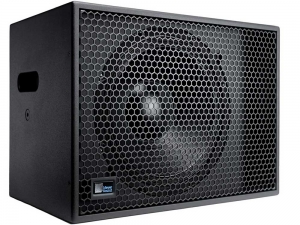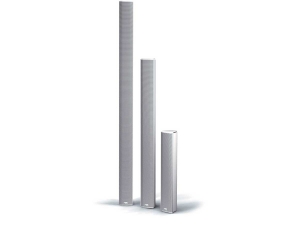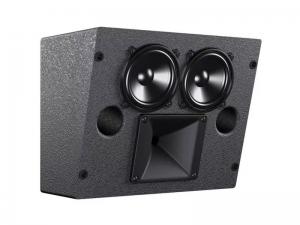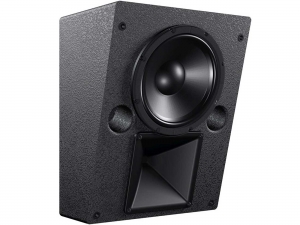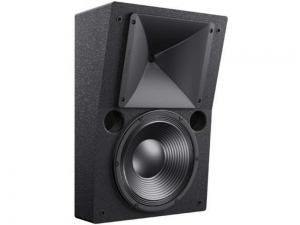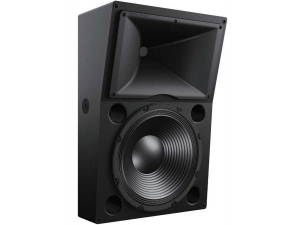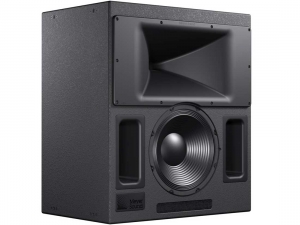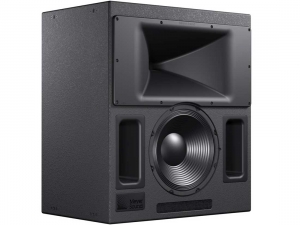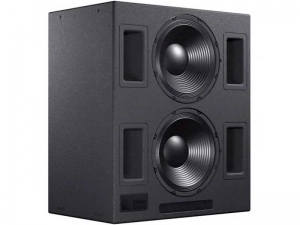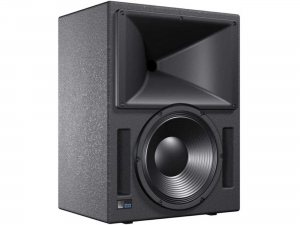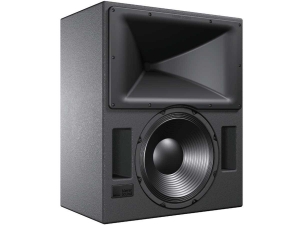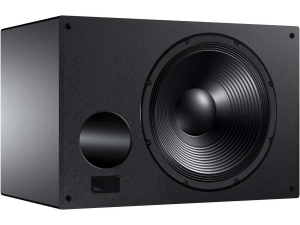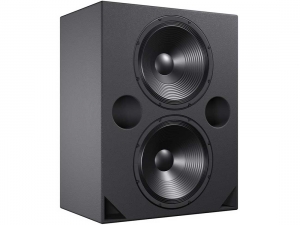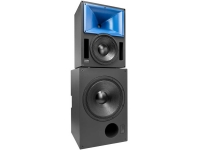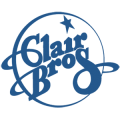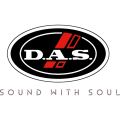ABOUT THE PRODUCT
ABOUT THE MANUFACTURER
GLOSSARY
Bluehorn System : Full Bandwidth Studio Monitor
The Bluehorn System
Meyer Sound designed The Bluehorn System Full Bandwidth Studio Monitor for the most demanding, critical-quality applications in music recording and mixing, music mastering, film scoring, film/video post-production and digital media content creation. Each Bluehorn System channel comprises a two-way, full-range loudspeaker and a separate low-frequency extension loudspeaker. The included external, dedicated Bluehorn 816 processing unit serves as an active crossover and also hosts the patented digital signal processing algorithms for full-bandwidth phase correction. Up to three Bluehorn System channels can be connected to each external processor. Bluehorn Systems are available in stereo and LCR configurations.A Breakthrough: Measurable and Audible
By combining—for the first time—high-power, full-bandwidth audio reproduction with unprecedented frequency and phase linearity, the Bluehorn System marks a breakthrough in studio monitoring. The best of prior monitoring systems have achieved a high degree of linearity in frequency response, but realizing the same degree of perfection in phase relationships had proven elusive.Now, after six years of intensive research and development, Meyer Sound has achieved the supreme goal: linear frequency and phase response from 25 Hz to 22 kHz.
The extraordinary linearity of the Bluehorn System is apparent in the phase and frequency plots shown in the following figure. The difference is even more revealing in a critical listening session. The Bluehorn system faithfully reproduces fine timbral details and subtle nuances, even at the lowest levels of audibility, and it reveals the ambience in recordings from naturally reverberant spaces with breathtaking realism. Regardless of output level, the response is neutral and transparent.
Pursuit of the Ultimate
Achieving perfectly linear response from a loudspeaker system has been a lifelong goal of company co-founder John Meyer. His first breakthrough came with the HD-1 studio monitor, introduced in 1989, which for decades has set the standard for accuracy and transparency in near-field studio monitors. The HD-1 marked a major leap forward in loudspeaker linearity, yet the technology of its time could not fully overcome the inherent obstacles presented by the physics of loudspeaker systems.Sources of Phase Shift
Complex sounds such as music comprise intricate patterns of air compression and rarefaction. High frequency sounds develop quickly and are tightly spaced, while lower frequencies develop more slowly with peaks and troughs further apart.But it is not only frequency and amplitude that matter changes in the relative time relationships among various frequencies during propagation can also produce audible effects. All larger, multi-way loudspeakers are inherently prone to such alterations—popularly known as phase shift—due to the mass and mechanical resistance of the drivers, crossover filtering, variations in driver alignment, and cabinet resonances.
Open-air electrostatic headphones come close to zero phase shift, thanks to their single drivers with extremely low mass. But in larger, multi-way systems that require the higher power of dynamic drivers, phase shift becomes an unavoidable compromise.
A Patented Solution
If phase shift cannot be eliminated from the acoustic output, then the only alternative is to compensate for the anomalies by introducing correction to the input signal. Phase correction in the analog domain has been implemented with some success in the past, but now the Bluehorn System applies advanced digital modeling to realize the ultimate goal: absolute phase accuracy across the entire audio bandwidth.The first step was to develop an integrated, self-powered monitoring system capable of flat amplitude response from 20 Hz to 22 kHz at high output levels with extremely low distortion. The project involved development of a new amplifier and inclusion of the newest driver technologies from the LEO Family line arrays.
The next step was meticulous measurement of the system’s phase behavior in Meyer Sound’s anechoic chamber, creating a precise model in response to all types of complex input signals. The final step was to create computer algorithms to cancel phase anomalies of the physical loudspeaker systems, ensuring that the phase relationships in the original program input are preserved in the acoustical output. The digital filters fundamental to the Bluehorn System have been awarded a United States Patent (9,992,573 B1).
Unflattering Transparency for Seamless Translation
The acoustic output of the Bluehorn System replicates the input signal, revealing every detail. It does not introduce flattering characteristics that could prove misleading when mixes have to translate to other rooms and other systems later in the production process. Monitoring on a Bluehorn System ensures that nothing is overlooked.Features
- Patented digital signal processing algorithms provide full-bandwidth (25 Hz to 22 kHz) phase correction
- Linear frequency response from 25 Hz to 22 kHz
- Replicates the input signal precisely in every dimension: frequency, amplitude, and time relationships between frequencies
- Consistent and accurate system results—no guess work, because the dedicated Bluehorn 816 processing unit includes all the active correction filters to drive the system.
- Overall system latency of < 50 ms. Notably fast for the amount of processing needed for phase correction down to 25 Hz.
Professional Applications
- Music mastering, recording and mixing
- Film sound design, score recording and mixing
- Film/video post-production
- Media content creation
- Research/acoustics reference and measurement source
- Screening rooms and quality control suites
Residential Applications
- Private Cinema
- Hi-fi
Professional used lighting equipment.| Professional second hand lighting equipment.| Professional pre owned lighting equipment.
Professional used audio equipment.| Professional second hand audio equipment.| Professional pre owned audio equipment.
Second hand audio gear. | Second hand lighting.
Pro audio equipment, second hand amplifiers, DJ, second hand sound systems, second hand Microphones, second hand Media Players.
Outdoor & Indoor LED screens for sale, LED mobile truck.
Light trussing, Gebrauchte Veranstaltungstechnik, used stage equipment Stage & Theatre lighting products.
Used Meyer Sound Laboratories
Meyer Sound Laboratories is an American company based in Berkeley, California that manufactures self-powered loudspeakers, multichannel audio show control systems, electroacoustic architecture, and audio analysis tools for the professional sound reinforcement, fixed installation, and sound recording industries.
The company’s emphasis on research and measurement has resulted in the issuance of dozens of patents, including for the now-standard trapezoidal loudspeaker cabinet shape. Meyer Sound has pioneered other technologies that have become standard in the audio industry, including: processor-controlled loudspeaker systems, self-powered loudspeakers,curvilinear arraying, cardioid subwoofers, and source independent measurement.
Meyer Sound has consistently involved itself with advanced research beyond that connected to immediate product development, sometimes in conjunction with arms of the University of California, Berkeley. Some of this research has resulted in unusual products such as their parabolic sound beam and sound field synthesis loudspeakers. Other projects, such as the spherical loudspeaker research underway by Meyer Sound and CNMAT (Center for New Music and Audio Technologies) at UC Berkeley are still in the stage of pure research.
Professional used lighting equipment.| Professional second hand lighting equipment.| Professional pre owned lighting equipment.
Professional used audio equipment.| Professional second hand audio equipment.| Professional pre owned audio equipment.
Second hand audio gear. | Second hand lighting.
Pro audio equipment, second hand amplifiers, DJ, second hand sound systems, second hand Microphones, second hand Media Players.
Outdoor & Indoor LED screens for sale, LED mobile truck.
Light trussing, Gebrauchte Veranstaltungstechnik, used stage equipment Stage & Theatre lighting products.
Active: Powered. An active crossover is electrically powered and divides the line-level signal prior to amplification. An active speaker includes an active crossover and built-in amplifier.
Actuality: Audio from an announcer speaking.
Amplifier: A component that increases the gain or level of an audio signal.
Balanced Input: A connection with three conductors: two identical signal conductors that are 180 degrees out of phase with each other, and one ground. This type of connection is very resistant to line noise.
Bandpass: A two-part filter that cuts both higher and lower frequencies around a center band. A bandpass enclosure cuts high frequencies by acoustic cancellation and low frequencies by natural physical limitations on bass response.
Bandwidth: In audio, the range of frequencies a device operates within. In video, the range of frequencies passed from the input to the output. Bandwidth can also refer to the transmission capacity of an electronic communications device or system the speed of data transfer,is very important when planning a meeting for the attendees to stay connected.
Bass: Low frequencies those below approximately 200 Hz.
Bi-Wiring: A method of connecting an amplifier or receiver to a speaker in which separate wires are run between the amp and the woofer and the amp and the tweeter.
Boost: To increase, make louder or brighter opposite of attenuate.
Bridging: Combining two channels of an amplifier to make one channel that more powerful. One channel amplifies the positive portion of an audio signal and the other channel amplifies the negative portion, which are then combined at the output.
CD: Compact Disc. Ubiquitous digital audio format. Uses 16-bit/44.1-kHz sampling rate PCM digital signal to encode roughly 74 or 80 minutes of two- channel, full-range audio onto a 5-inch disc.
CD-R: Recordable Compact Disc.
CD-RW: Rewritable Compact Disc.
Channel: In components and systems, a channel is a separate signal path. A four-channel amplifier has at least four separate inputs and four separate outputs.
Coloration: Any change in the character of sound (such as an overemphasis on certain tones) that reduces naturalness.
Crossover: A component that divides an audio signal into two or more ranges by frequency, sending, for example, low frequencies to one output and high frequencies to another. An active crossover is powered and divides the line-level audio signal prior to amplification. A passive crossover uses no external power supply and may be used either at line level or, more commonly, at speaker level to divide the signal after amplification and send the low frequencies to the woofer and the high frequencies to the tweeter.
Crossover Frequency: The frequency at which an audio signal is divided. 80 Hz is a typical subwoofer crossover point and is the recommended crossover point in theatrical and home THX systems. Frequencies below 80 Hz are sent to the subwoofer signals above 80 Hz are sent to the main speakers.
Cut: To reduce, lower opposite of boost.
Decibel (dB): A logarithmic measurement unit that describes a sound`s relative loudness, though it can also be used to describe the relative difference between two power levels. A decibel is one tenth of a Bel. In sound, decibels generally measure a scale from 0 (the threshold of hearing) to 120-140 dB (the threshold of pain). A 3dB difference equates to a doubling of power. A 10dB difference is required to double the subjective volume. A 1dB difference over a broad frequency range is noticeable to most people, while a 0.2dB difference can affect the subjective impression of a sound.
Delay: The time difference between a sonic event and its perception at the listening position (sound traveling through space is delayed according to the distance it travels). People perceive spaciousness by the delay between the arrival of direct and reflected sound (larger spaces cause longer delays.
Diaphragm: The part of a dynamic loudspeaker attached to the voice coil that produces sound. It usually has the shape of a cone or dome.
Diffusion: In audio, the scattering of sound waves, reducing the sense of localization. In video, the scattering of light waves, reducing hot spotting, as in a diffusion screen.
Digital Audio Server: Essentially a hard drive, a digital audio server stores compressed audio files (like MP3 or WMA). Most include the processing to make the files, and all have the ability to play them back.
Direct-Stream Digital: A format for encoding high-resolution audio signals. It uses a 1-bit encoder with a sampling rate of 2,822,400 samples per second (verses 44,100 for CD). Used to encode six high-resolution channels on SACD.
Dispersion: The spread of sound over a wide area.
Distortion: Any undesired change in an audio signal between input and the output.
DNR: Dynamic Noise Reduction. A signal-processing circuit that attempts to reduce the level of high-frequency noise. Unlike Dolby NR, DNR doesn't require preprocessing during recording.
Dolby B: A noise-reduction system that increases the level of high frequencies during recording and decreases them during playback.
Dolby C: An improvement on Dolby B that provides about twice as much noise reduction.
Dolby Digital: An encoding system that digitally compresses up to 5.1 discrete channels of audio (left front, center, right front, left surround, right surround, and LFE) into a single bitstream, which can be recorded onto a DVD, HDTV broadcast, or other form of digital media. When RF-modulated, it was included on some laser discs, which requires an RF-demodulator before the signal can be decoded. Five channels are full-range the .1 channel is a band-limited LFE track. A Dolby Digital processor (found in most new receivers, preamps, and some DVD players) can decode this signal back into the 5.1 separate channels. Most films since 1992`s Batman Returns have been recorded in a 5.1 digital format, though a number of films before that had 6-channel analog tracks that have been remastered into 5.1.
Dolby EX: An enhancement to Dolby Digital that adds a surround back channel to 5.1 soundtracks. The sixth channel is matrixed from the left and right surround channels. Often referred to as 6.1. Sometimes referred to as 7.1 if the system uses two surround back speakers, even though both speakers reproduce the same signal. Software is backwards-compatible with 5.1 systems, but requires an EX or 6.1 processor to obtain additional benefit.
Dolby Pro Logic: An enhancement of the Dolby Surround decoding process. Pro Logic decoders derive left, center, right, and a mono surround channel from two-channel Dolby Surround encoded material via matrix techniques.
Dolby Pro Logic II: An enhanced version of Pro Logic. Adds improved decoding for two-channel, non-encoded soundtracks and music.
Driver: A speaker without an enclosure also refers to the active element of a speaker system that creates compressions and rarefactions in the air.
DSP: Digital Signal Processing. Manipulating an audio signal digitally to create various possible effects at the output. Often refers to artificially generated surround effects derived from and applied to two-channel sources.
DTS: Digital Theater Systems. A digital sound recording format, originally developed for theatrical film soundtracks, starting with Jurassic Park. Records 5.1 discrete channels of audio onto a handful of laser discs, CDs, and DVDs. Requires a player with DTS output connected to a DTS processor.
DTS ES: An enhanced version of the 5.1 DTS system. Like Dolby's Surround EX, a sixth channel is added. In some cases (DTS ES Discrete), the sixth channel is discrete. Software is backwards-compatible with 5.1 systems, but requires an ES or 6.1 processor to obtain additional benefit. Neo: 6 is a subset of DTS ES that creates 6.1 from material with fewer original channels.
Dynamic Range: The difference between the lowest and the highest levels in audio, it&'s often expressed in decibels. In video, it's listed as the contrast ratio.
Professional used lighting equipment.| Professional second hand lighting equipment.| Professional pre owned lighting equipment.
Professional used audio equipment.| Professional second hand audio equipment.| Professional pre owned audio equipment.
Second hand audio gear. | Second hand lighting.
Pro audio equipment, second hand amplifiers, DJ, second hand sound systems, second hand Microphones, second hand Media Players.
Outdoor & Indoor LED screens for sale, LED mobile truck.
Light trussing, Gebrauchte Veranstaltungstechnik, used stage equipment Stage & Theatre lighting products.

